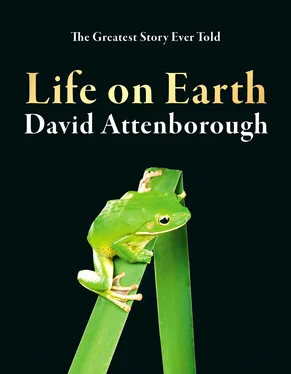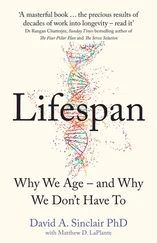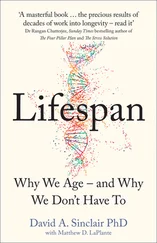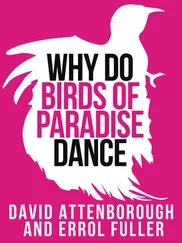The presence of these large populations of insects, whirring and buzzing through the air of the ancient forests, was eventually to play an extremely important part in a revolution that was taking place among the plants.
The early trees, like their predecessors, the mosses and liverworts, existed in two alternating forms, a sexual generation and an asexual one. Their greater height posed no problem for spore dispersal: if anything it was a help, since up in the treetops spores were more easily caught by the wind and carried away. The distribution of sex cells, however, was a different matter. Hitherto, it had been achieved by the male cells swimming through water, a process which demanded that the sexual generation be small and live close to the ground. That of ferns, club mosses and horsetails still is. The spores of these plants develop into a thin filmy plant called the thallus which looks not unlike a liverwort and releases its sex cells from its underside where there is permanent moisture. After its eggs have been fertilised, they grow into tall plants like the previous spore-producing generation.
On the ground, the thallus is clearly vulnerable. It is easily grazed by animals; if it dries out it dies; and the very success of the asexual generation with their arching fronds cuts it off from life-giving light. Many advantages would follow if it too could grow tall, but this would require a new technique for getting the male cell to the female.
There were two mechanisms available – the ancient, rather hazardous and capricious method that distributed spores, the wind; and the newly arrived messenger service, the flying insects, which were now regularly moving from tree to tree, feeding on the leaves and the spores. Plants took advantage of both mechanisms. About 350 million years ago, some appeared in which the sexual generation no longer grew flat on the ground, but up in the crowns of the trees. One group among these plants, the cycads, survives today and shows the development at a particularly dramatic stage.
Cycads look superficially like ferns, with long coarse feathery fronds. Some individuals produce tiny spores of the ancient type that can be distributed by the wind. Others develop much larger ones. These are not blown away but remain attached to the parent. There they develop the equivalent of the thallus, a special kind of conical structure within which eggs eventually appear. When a wind-blown spore – which now can be called pollen – lands on an egg-bearing cone, it germinates, not into a filmy thallus for which there is now no need, but into a long tube which burrows its way down into the female cone. The process takes several months. Eventually, when the tube is complete, a sperm cell is produced from the end of the tube. It is a majestic ciliated sphere, the largest known sperm of any organism, plant or animal, so big that a single one is visible to the naked eye. Slowly it makes its way down the tube. When it reaches the bottom, it enters a small drop of water that has been secreted by the surrounding tissues of the cone. There it swims, slowly spinning, driven by its cilia, as it re-enacts in miniature the journeys made through the primordial seas by the sperm cells of its algal ancestors. Only after several days does it fuse with the egg and so complete the long process of fertilisation.
Another group of plants adopting a similar strategy to the cycads arose at about the same time. These were the conifers – pines, larches, cedars, firs and their relations. They too rely on the wind to distribute their pollen. Unlike the cycads, they produce both pollen and egg-bearing cones on the same tree. The process of fertilisation in a pine takes even longer. The pollen tube requires a whole year to grow down and reach the egg, but once there, it contacts the egg cell directly, and the male cell, after descending the tube, does not tarry in a drop of water but fuses directly with the egg. The conifers have at last eliminated water as a transport medium for their sexual processes.

Common hawker dragonfly ( Aeshna juncea ) on Brackish Moss National Nature Reserve, County Armagh, Northern Ireland.
Cones of the Eastern Cape giant cycad, or bread tree ( Encephalartos altensteinii ). Present day cycads are survivors of a group dating back 300 million years. Most families died out during the Cretaceous period, 80 million years ago. Cycads are of great evolutionary interest due to their reproductive system, considered to be the forerunner of flowering plants. The cones are the reproductive structures and can be male or female, producing seeds to form new plants.
They have also developed one further refinement. The fertilised egg remains in the cone for one more year. Rich food supplies are laid down within its cells and waterproof coats are wrapped round it. Eventually, more than two years after fertilisation began, the cone dries and becomes woody. Its segments open, and out drop the fertilised fully provisioned eggs – seeds – which if necessary can wait for years before moisture penetrates them and stimulates them to spring to life.
By any standards, the conifers are a great success. Today, they constitute about a third of the forests of the world. The biggest living organism of any kind is a conifer, the giant redwood of California, which grows to 100 metres in height. Another conifer, the bristle-cone pine, which grows in the dry mountains of the southwestern United States, has one of the longest life-spans of any individual organism. The age of trees can easily be calculated if they grow in an environment where there are distinct seasons. In summer, when there is plenty of sunshine and moisture, they grow quickly and produce large wood cells; in winter, when growth is slow, the cells are smaller and the wood consequently more dense. This produces annual rings in the trunk. Counting those in the bristle-cone pine establishes that some of these gnarled and twisted trees germinated over five thousand years ago at a time when people in the Middle East were just beginning to invent writing, and the trees have remained alive throughout the entire duration of civilisation.
Conifers protect their trunks from mechanical damage and insect attack with a special gummy substance, resin. When it first flows from a wound it is runny, but the more liquid part of it, turpentine, quickly evaporates, leaving a sticky lump which seals the wound very effectively. It also, incidentally, acts as a trap. Any insect touching it becomes inextricably stuck and very often buried as more resin flows around it. Such lumps have proved to be the most perfect fossilising medium of all. They survive as pieces of amber and contain ancient insects in their translucent golden depths. When the amber is carefully sectioned, it is possible, through the microscope, to see mouthparts, scales and hairs with as much clarity as if the insect had become entangled in the resin only the day before. Scientists have even been able to distinguish tiny parasitic insects, mites, clinging to the legs of the bigger ones. Extracting the DNA from a blood-sucking arthropod seems likely to remain science fiction, however. Even attempts to do so from insects trapped in copal, the modern equivalent of amber only a few decades old, have all met with failure.
The oldest pieces of amber so far discovered date from around 230 million years ago, a long time after the conifers and the flying insects first appeared, but they contain a huge range of creatures, including representatives of all the major insect groups that we know today. Even in the earliest specimens, each type has already developed its own characteristic way of exploiting that major insect invention, flight.
Читать дальше













